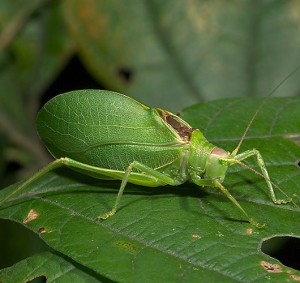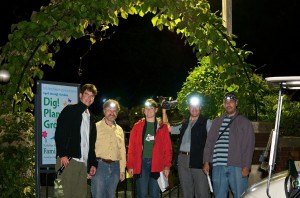Yes, We Do Have Katydids
Posted in Science, Wildlife on September 24 2009, by Plant Talk
Cricket Crawl at the Garden Confirms Presence of These—and More
 |
Jessica Arcate is Manager of the Forest. |
 |
Robert Naczi, Ph.D., is Curator of North American Botany. |
 On the evening of Saturday, September 12, a fearless group of five naturalists outfitted with headlamps and recording equipment, ventured throughout the Botanical Garden to listen for seven species of crickets and katydids for the NYC Cricket Crawl.
On the evening of Saturday, September 12, a fearless group of five naturalists outfitted with headlamps and recording equipment, ventured throughout the Botanical Garden to listen for seven species of crickets and katydids for the NYC Cricket Crawl.
We were inspired to do the count, arranged by the U.S. Geological Survey (USGS) and others, after reading about the mystery of the “missing katydid of New York City.” It seems that in 1920, local naturalist William T. Davis reported the possible disappearance of the Common True Katydid (pictured here, Photo by ©MusicofNature.org) from Staten Island. Present-day experts on katydids and crickets surmised that katydids might be like the fabled canary in a coal mine, lost to environmental toxins, and so decided to organize the survey. Several species are common in the region and call at night with sounds easy to distinguish, permitting an observer to list the species present in an area just by listening to them. The Cricket Crawl promised to reveal patterns of biodiversity relevant to such matters as climate change, effects of deforestation, and adaptations of wildlife to urban areas.
Actually, we wondered why all the fuss about katydids? We knew we had them here at The New York Botanical Garden. As part of the efforts to document the natural history of NYBG, Edgardo Rivera and Robert Naczi had been studying insects at NYBG since mid-July. Because many insects find ultraviolet light (“black light”) irresistible, nocturnal collecting with a black light can be a very productive way of surveying local insect diversity. Edgardo and Rob had heard Common True Katydids at NYBG on several occasions, but came to realize their significance after reading announcements about the Cricket Crawl.
 And so a team was assembled (see photo by Tom Andres) to confirm the identities of these insects for the Cricket Crawl: Edgardo Rivera (Senior Curatorial Assistant), Tom Andres (Herbarium volunteer), Kendrick Simmons (independent videographer), Jim Schuler (volunteer), and Jessica Arcate (Manager of the Forest). The evening began in the Perennial Garden and Ladies’ Border, and then headed to the knolls of the Arthur and Janet Ross Conifer Arboretum. At these sites four species were heard: Jumping Bush Cricket, Field Cricket, Greater Anglewing, and Common True Katydid. At the Mitsubishi Wetlands the fifth and last species of the night was added to the list, the Oblong-winged Katydid. Next, the team trekked into the center of the Forest. To our surprise one of the great horned owls from the Garden’s resident family was calling. The owl called several times from different trees, and it was incredible to hear. (To hear the sound of a great horned owl, click here.)
And so a team was assembled (see photo by Tom Andres) to confirm the identities of these insects for the Cricket Crawl: Edgardo Rivera (Senior Curatorial Assistant), Tom Andres (Herbarium volunteer), Kendrick Simmons (independent videographer), Jim Schuler (volunteer), and Jessica Arcate (Manager of the Forest). The evening began in the Perennial Garden and Ladies’ Border, and then headed to the knolls of the Arthur and Janet Ross Conifer Arboretum. At these sites four species were heard: Jumping Bush Cricket, Field Cricket, Greater Anglewing, and Common True Katydid. At the Mitsubishi Wetlands the fifth and last species of the night was added to the list, the Oblong-winged Katydid. Next, the team trekked into the center of the Forest. To our surprise one of the great horned owls from the Garden’s resident family was calling. The owl called several times from different trees, and it was incredible to hear. (To hear the sound of a great horned owl, click here.)
The expedition continued across the Garden, stopping at the northern part of the Forest, the Oak Collection, and Family Garden. Brown bats were very active in the Rose Garden and in the Benenson Ornamental Conifers. To complete the tour, the group stopped along Azalea Way and on the main lawns in front of the Library building. A full account of the evening can be found on the expedition blog, which was done in real time from about 8 p.m. to 10:30 p.m., thanks to the dedicated blogger Ann LaVigna at the University of Maryland, and to the Cricket Crawl organizer Sam Droege from the USGS Patuxent Wildlife Research Center in Beltsville, MD.
Yes, we do have katydids! In fact, Common True Katydids were among the most common and easiest to hear of the target cricket and katydid species. Some other teams of observers reported hearing Common True Katydids at a few other sites in New York City, including Staten Island. Refuting the disappearance of this insect from NYC is good news and very exciting. We are particularly pleased that the significance of NYBG, particularly the Forest, as a refuge for wildlife continues to be evident.
It was an extraordinary evening that allowed us to focus on insect sounds—many that we do notice with seasonal change throughout the year but whose distinct differences and overall importance we never really pay attention to. The Cricket Crawl collected valuable data throughout the tri-state area, and publicized awareness for the seven species of insects whose calls all Citizen Scientists that evening learned to recognize. With the Cricket Crawl fresh in our ears, we will now hear the sounds of nature all around us in a new way.


Katydids are so adorable and cute!!!!